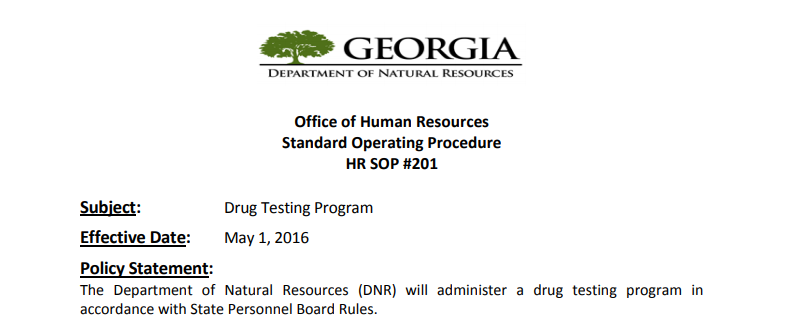.jpg)
Effective processes are the backbone of any successful business. A key component of managing these processes is having clear standard operating procedures (SOPs).
A standard operating procedure (SOP) ensures everyone is on the same page with what to do and how to do it. This alignment leads to smooth business operations. Without SOPs, confusion can quickly set in, derailing productivity.
In this article, we're going to cover:
- What an SOP is
- Benefits of having standard operating procedures
- Guidelines for writing and developing effective standard operating procedures
- Popular standard operating procedure formats
- Challenges of developing standard operating procedures
- Example use cases of SOPs by industry
- Standard operating procedures examples and templates
- Key Takeaways/TLDR
- Why you should consider a knowledge base for your SOPs
What is a Standard Operating Procedure?
A standard operating procedure (SOP) gives you the step-by-step instructions needed to perform specific tasks consistently and efficiently.
The purpose of SOPs is essentially to be a go-to guide for solving problems, ensuring safety, and maintaining high performance across your company.

What is the Difference Between an SOP and a Process Document?
While a process document gives you a broad overview, an SOP dives deep into the details, laying out the exact steps needed for success. Imagine a process document as a sketch of the journey from "Point A" to "Point B," whereas an SOP is your detailed map, guiding you every step of the way.
Why Are Standard Operating Procedures Important?
The value of standard operating procedures extends beyond their fundamental purpose of ensuring consistency and reducing miscommunication. They serve as a blueprint for success by helping organizations standardize their internal processes and progress in a unified, cohesive manner.
Imagine the consequences of not having SOPs in place - it would leave too much up to chance. Without them, there's no guarantee that best practices would be followed consistently, that team members would remain in sync, or that the organization would continue to operate optimally.
Benefits of Implementing Standard Operating Procedures
Let's take a closer look at the specific benefits that SOPs bring to a business.
- Ensures Adherence to Best Practices. An SOP turns best practices from suggestions into clear steps, making sure your team always works in the company's best interest. SOPs provide detailed instructions to guide your team, helping them achieve great results while saving resources.
- Ensures Consistency and Efficiency. A standard operating procedure is the blueprint for making your organization run like a finely-tuned machine. It establishes consistency in your operations, making decisions and processes more automatic, thus eliminating unnecessary deliberations or miscommunication.
- Reduction of Misunderstandings. SOPs provide clear, detailed instructions on task execution, ensuring everyone is on the same page and reducing potential misunderstandings. This fosters effective communication within the team.
- Enables Proper Onboarding and Training. Clearly defined standard operating procedures make employee onboarding easier as well as improve how you train your team members on best practices. With detailed steps and contingency plans, employees are better prepared to handle challenges.
- Preservation of Organizational Knowledge. Although your current team might be well-versed with the SOPs, it's crucial to document them for future reference. Changes in your team are inevitable - retirement, resignation, promotions, leaves, etc. When changes happen, documented SOPs retain knowledge and expertise within the company for new members.
- Quality Assurance. By ensuring adherence to best practices and maintaining consistency, SOPs enhance the overall quality of work. The workers can effectively and efficiently complete a process or task, raising the quality bar.
- Regulatory Compliance. Certain industries legally require SOP documentation. Well-documented SOPs demonstrate compliance with regulatory requirements, such as adherence to the Joint Commission's standards in healthcare. They also help fulfill general legal obligations, like customer complaint resolution, by outlining necessary steps to meet terms of service.
- Improved Safety. SOPs detail safe practices and procedures, reducing the risk of accidents or injuries. For example, an SOP for handling hazardous materials includes steps for appropriate protective gear and handling techniques, ensuring safety and proper risk assessment.
How to Write an Effective Standard Operating Procedure
Alright, we've tackled the basics: we understand what a standard operating procedure (SOP) is and why they can be such a game changer when effectively creating and implementing them.
Are you ready for the next step? Let's dive in and uncover how to write an SOP that your team will actually want to use.
Below are the general steps to take when writing a standard operating procedure.
- Determining Your Goals for Creating an SOP
- Determine the Stakeholders and Creators
- Define the End-User
- Determine the Scope and Format of the SOP
- Gather All Information
- What Should Be Included in Your SOP
- Review the Written Document
- Train Your End-Users
- Test and Tweak the SOP in Practice
- Implement SOP—and Revisit Regularly
Now, let's dive deeper into the actual process of crafting effective standard operating procedures.
The steps we discuss below are based on our extensive experience and proven success in developing SOPs here at Helpjuice. Our goal is to share our best practices with you, so that you too can create and implement SOPs that streamline your internal processes.
1. Define Your Objectives for Creating an SOP
Before the pen hits the paper, or fingers touch the keyboard, you should have a clear-cut answer to the question of why you're creating this document. It's like preparing for a road trip; you need to know your destination before you can plan your route.
Let's explore some questions to help shape your mission:
- How can SOP documentation amp up efficiency and teamwork among your employees?
- What does customer service look like when everyone sticks to an SOP?
- How will implementing an SOP boost the company's bottom line?
Next, identify any hiccups in your current workflow. That way, you can zero in on how your team can boost productivity with an SOP in place.
Action Step: Set up a meeting with your team to brainstorm and finalize your SOP objectives. Make them SMART goals, and you're off to a great start!
Pro Tip: Consider using a knowledge base tool at this stage—and throughout the entire process—to enhance your team's productivity and keep all documentation stored and organized.
2. Determine the Stakeholders and Creators
Assemble your A-team: Drawing from our experience in developing SOPs, it's essential to involve all personnel who will be engaging in or affected by the SOP in the document's development process.
- C-level executives – the big guns, focused on crafting lean operations and achieving high-level business goals.
- Management leaders – the tacticians, who develop best practices and put together a plan for SOP implementation.
- Ground-level employees – the foot soldiers, who can judge the feasibility of the SOP in terms of logistics and resource consumption.
Action Step: List down all the possible stakeholders for your SOP, along with their respective roles.
Note: Consider the impact on your customers. While SOPs primarily address internal processes they can impact the customer experience. So, design SOPs that streamline internal processes as well as enhance customer satisfaction.
3. Define the End-User
Who will be using the SOP? While many people may help create an SOP, it is mainly used by specific employees or departments. For instance, an SOP for customer service requests would be mainly used by customer service reps.
That's why knowing who will use the SOP helps you make it useful and practical for those people using it.
This means:
- Remaining laser-focused on the actual duties of the end-user
- Using the correct language and terminology, as expected by the end-user
- Explaining certain terminology as needed, while not over-explaining processes and terms that are second-nature to the end-user
But, before you can make any of this happen, you need to have a clear idea of who within your organization your SOP is being created for.
4. Determine the Scope and Format of the SOP
Determining the scope of an SOP involves considering several factors. First, think about who will be using the SOP, as discussed in the previous step. Next, identify what equipment or materials are needed. Finally, consider any other factors that may affect the task or process described in the SOP.
When it comes to formatting, a standard operating procedure typically falls into one of the following categories:
- Step-by-step written list
- Hierarchical list
- Flowchart
- Simple checklist
- Video
- Interactive course
Determine which format will best communicate the information based on the procedures you are documenting.
The best course of action here is to go with the simplest format necessary for the circumstance at hand. If there’s no need for additional explanations or contingencies, a step-by-step list may be sufficient. However, if each step can lead to multiple outcomes, a flowchart is likely necessary.
5. Gather All Information
OK, so you've determined why you need to create the standard operating procedure as well as know who you're creating it for. You even know who will be responsible for writing the standard operating procedure. The only thing left before writing the SOP is to gather the necessary information which includes:
- Research the task or process: Look for relevant information about the task or process that the SOP will cover. This may include industry guidelines, best practices, and any relevant policies or procedures.
- Consult subject matter experts: Seek input from individuals who have expertise in the task or process that the SOP will cover. These individuals may be able to provide valuable insights and information that will help you create a more comprehensive and accurate SOP.
- Review existing policies and procedures: If there are any existing policies or procedures that relate to the task or process described in the SOP, be sure to review them and incorporate any relevant information into the SOP.
- Observe the task or process: If possible, observe the task or process being performed to get a better understanding of the steps involved and any challenges or issues that may arise.
6. Outline the SOP Document—and Begin Writing It
Once you know your goals for creating the SOP, who will be involved, and the best format to use, you can start the planning process.
Here, we’ll discuss the parts of a complete standard operating procedure document and explain what to include.
Note: One thing to keep in mind as you write your SOP is to use clear, concise language and formatting. Avoid using jargon or complex language, and use bullet points or numbered lists to make the SOP easy to read and follow. When possible, use active voice instead of passive voice to make the instructions more clear and more direct.
Title Page
The title page of your standard operating procedure should contain identifying information regarding the document, including:
- The SOP being documented
- The document’s unique identification number
- The date of creation and/or editing of the document
- The department or professional title of the entity who will implement the SOP
- The names and titles of the individuals who created the document
(Source. Example of SOP Title Page From Georgia's Department of Natural Resources' HR Team)
Table of Contents
If necessary, you can include a table of contents after the title page of your SOP, as this will help those who use the document find the information they’re seeking with relative ease.
This may only be necessary if the SOP document is longer than a page or two. Basically, if the end-user is able to quickly and easily find the information they need without a table of contents, you likely don’t need to include it in the document.
Preparatory Information
As we’ve discussed, certain information will need to be laid out in full in order for your team to be able to adhere to the SOP to be described momentarily.
This preliminary information includes:
- SOP Purpose: Here, you’ll explain your team’s rationale for creating the SOP document. This means explaining the high-level and “on-the-ground” impact you hope the SOP to have on your organization, as well as the actual standards to be met by implementing the SOP.
- Roles and Responsibilities: In this section, you’ll identify the specific employees or stakeholders to be involved in a given process. Moreover, you’ll also define the capacity of these individuals within your organization, as well as the role they play in the SOP in question.
- Resources and Materials: The individuals responsible for completing the procedure will likely need to use a variety of tools, technology, and other materials throughout the process. Here, you’ll define what these resources are, and any other necessary information about them (e.g., where to find them within your facilities, how to store them properly, and how and when to request maintenance if need be).
- Cautions, Warnings, and Other Hazard-Related Info: If any safety precautions exist with regard to the aforementioned resources, or to the overall procedure in question, it’s imperative that you lay them out clearly, here. This information should also be present within the SOP documentation to follow, with clear indicators of how to find more information if needed.
Methodology and Procedures
This section is, of course, the most important part of the overall SOP document, as it’s where you’ll describe the actual operating procedures to be followed at all times when completing a certain task.
Using the chosen format, your task here will be to write detailed, step-by-step instructions for the end-user to follow at every touchpoint. In more simplified cases, these steps will be sequential; in others, the process may involve sub-steps, recursive processes, decision trees, and the like.

(Source. Example of Procedural Steps From NC State University)
As we’ve discussed, it’s essential to be as detailed and clear as necessary throughout this section of the SOP. The goal is to use as specific language as is needed to communicate instructions in full—and to minimize any ambiguity that may exist within said instructions.
(To that point, it’s worth noting that you only need to be specific enough for the intended audience to understand the instructions in question. In other words, there’s no need to be specific to the point of being pedantic; make your instructions clear, and then allow the end-user to get to work.)
Depending on the procedure in question, you’ll also want to include any diagrams, illustrations, or other imagery that may supplement your written documentation. In fact, it may be more effective and efficient to use such illustrations in certain circumstances where the written word simply doesn’t suffice.
Quality Control and Assurance
It’s essential that your team members are able to assess their performance with regard to SOP on a case-by-case basis and at specifically-defined intervals over time.
In this section, then, you’ll want to include documentation that allows them to do so. This may include:
- Anecdotes illustrating best practices with regard to a specific procedure
- Rubrics or similar means of measuring performance
- Samples (real or simulated) of past performance evaluations
While the “meat” of your SOP should be as detailed as possible, this section will ensure that your team members continue to adhere to SOP to the best of their abilities—and are also able to identify areas in which they may need to make improvements moving forward.
References and Glossary
You’ll likely refer to a variety of terms, resources, and other documents throughout a given SOP that may require further explanation.
In this section, you’ll be able to either provide this explanation in the necessary detail, or point your audience toward additional resources or documentation for further explanation. This will allow you to maintain a singular focus within the current SOP document, while also providing the opportunity for the end-user to dig deeper into a given topic should they need to do so.
7. Proofread, Test, and Revise: The Iterative Process
An SOP, like any masterpiece, isn't usually perfect in its first draft. Imagine if J.K. Rowling had published the first draft of Harry Potter. Would it have become the phenomenon it is today? Probably not.
Proofreading, testing, and revising are all essential steps to creating an effective SOP. Involve your team in this step, because a different set of eyes can catch issues you might have missed.
Action Step: Create a test group within your team to implement the SOP in a controlled environment. Gather their feedback, make necessary revisions, and repeat the process until you have an SOP that works seamlessly.
8. Train Your End-Users
No matter how experienced or specialized your current team members are, they will need to be trained (and/or retrained) as to the new SOP to be implemented.
This, of course, can be a sensitive area—especially for long-time employees who are used to going about tasks in a certain manner, and who may not yet see the benefits of making the necessary improvements.
For this reason, it’s vital that these SOP training sessions occur in a relaxed, no-risk atmosphere. Your team needs to have full confidence that this isn’t a “gotcha”-type ordeal; rather, it’s to better enable them to put their best foot forward, and to be as productive as possible in their contractual duties.
As we’ll discuss in the following sections, you’ll also want to point out to your team that this training isn’t just a one-off thing—it’s an ongoing process. This will reinforce the idea that the new SOP is and will be the new way of doing things, and will not be put to the backburner after the novelty of the new process wears off.
That said, the idea of training your team with regard to new SOP deals only in part with the actual procedures in question, while focusing more on instilling in your team a growth mindset.
9. Leverage Standard Operating Procedure Software
Utilizing SOP software can significantly simplify the process of creating, managing, and distributing SOPs. With built-in features for easy formatting, revision tracking, approval workflows, and centralized access, it's an invaluable tool for SOP management.
Action Item: Research and choose SOP software that fits your company's needs. Provide the necessary training to your team for its effective use. In case you find that SOP software requires too much commitment, you can opt for a simple free SOP template from HubSpot.
10. Implement SOP—Revisit Regularly and Update as Needed
The “final” stage of the process is, of course, to implement the new SOP in full.
We put the word “final” in quotation marks because, again, what’s considered “best practices” in a given scenario is constantly in flux. To be sure, what works best today may be a rather inefficient way to go about doing things mere months from now.
This is why it’s important to instill a growth mindset in your team: They need to understand that the new processes are not set in stone, and will evolve over time as the need arises.
Not only do they need to understand this—they also need to be a part of it. As your team continues to adhere to the new SOP, they should regularly take note of any positive or negative experiences they have along the way. Basically, this means noticing areas of improvement, as well as areas in which more improvements need to be made.
In addition to any “on-the-fly” noticing, your team should also meet regularly to discuss further plans for moving forward. Typically, this will mean amending the SOP in relatively minor ways—but could also involve rebuilding the entire document from scratch, if need be.
It’s also important to consider any external factors that may require your team to revisit the SOP. These factors include legislative changes, technological advancements, and/or shifts in consumer needs.
In solidifying an effective and efficient SOP you allow your team to be as productive as possible given your organization’s current overall circumstances—while keeping the door open to make improvements to your processes as these circumstances change.
Finally, be sure to review and update the SOP as necessary to ensure that it remains accurate and effective.
Standard Operating Procedure Formats
While companies are free to develop their internal SOP documents in a format that works best for their team, in our experience most organizations choose from one of the following standard operating procedure formats.
1. Step-by-Step Written Format
In some cases, it may be sufficient to create a simple numbered or bulleted list of steps to take when completing a process.
This format should be used only when the process in question is straightforward and, in the vast majority of circumstances, can be completed without fail.
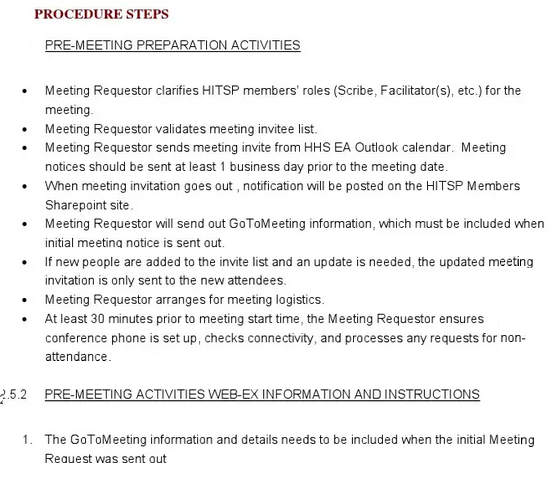
Processes in which a step-by-step format is likely sufficient include:
- Setup and cleanup instructions
- Digital login sequences
- Instructions for proper and safe use of equipment
2. Hierarchical Format
The hierarchical format for SOPs borrows from the above format in that it involves listing the steps of the process to be completed.
However, hierarchical SOPs provide additional details within each step as deemed necessary. While a purely step-by-step SOP will list steps 1, 2, 3, and so forth, a hierarchical SOP may include Steps 1a and 1b; 2a, 2b, 2c; 3a, 3b.

The hierarchical format is used when more instruction may be needed in order to sufficiently complete a given task. As a simple example, if Step 1 tells team members to log into their account, Step 1a may direct individuals to input their username, with Step 1b directing them to input their password.
3. Flowchart Format
Flowcharts are best used to illustrate SOPs when multiple outcomes are possible at certain points throughout the process.
In such cases, the outcome of one step will impact the way in which the team will need to approach each subsequent step.
Take a look at the following workflow, for example:
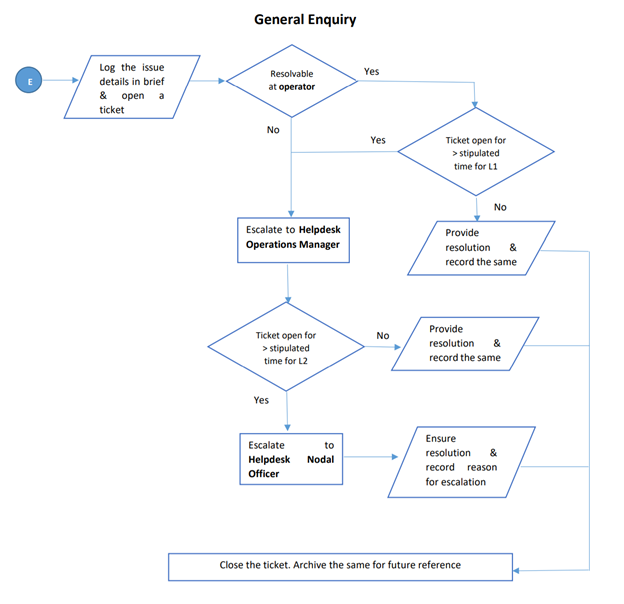
(Source)
Note that, in this example, there are multiple times in which a decision must be made as to how to proceed. Basically, each subsequent step depends on the outcome of the previous step—and it simply wouldn’t be logical to follow certain paths if a contrasting outcome were to come about.
4. Checklist Format
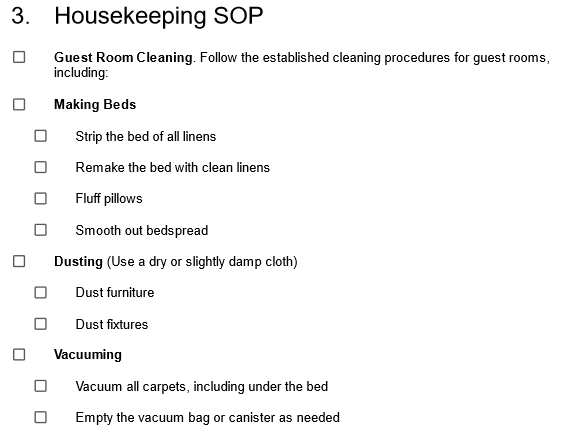
Checklist SOPs are presented as a simple list of steps that need to be followed in order. This can be a helpful format for SOPs that involve repetitive tasks or that need to be completed quickly.
5. Video Format
A video standard operating procedure is a visual guide that uses video footage to demonstrate how to complete a specific task or process. Video SOPs can be an effective tool for training and onboarding new employees, as they allow workers to see exactly how a task should be performed. They can also be useful for documenting and standardizing processes, as they provide a clear, visual representation of the steps that need to be followed.
Video SOPs can provide a more interactive and engaging way to learn than written SOPs as viewers can see how tasks should be performed, rather than just reading about them. This format is particularly useful for workers who are visual learners or who prefer to learn through demonstrations.
6. Interactive Course
SOPs can be formatted as an interactive online course, combining written instructions, video demonstrations, and quizzes to guide users through a task or process. This can be a helpful format for SOPs that need to be completed by a large number of people or that involve multiple skills or concepts.
What are the Challenges of Developing a Standard Operating Procedure?
While there are many benefits to developing SOPs within your organization, creating effective standard operating procedures that are followed comes with its fair share of challenges as well.
1. Compartmentalized Development
There’s a reason your development of SOPs should be an “all-hands-on-deck” affair:
Basically, if only certain stakeholders are involved, you’ll run the risk of your SOPs missing the mark in some way or another.
For example, if an SOP is created solely by C-level executives, it may focus more on the goal to be attained than the process required to attain it. This can cause the ground-level team to run into a variety of obstacles that the executives may not have anticipated—meaning the SOP in question actually isn’t in-line with what would be considered “best practices” for the given circumstances.
On the other hand, if created solely by managerial staff, the SOP may not take into consideration C-level goals, such as minimizing resource consumption and improving the bottom line. In this scenario, you may have on-the-ground teams completing tasks in a way that may seem efficient, but that isn’t really doing all that much for the business as a whole.
That said, the process of developing SOP needs to involve all stakeholders at all times. This will ensure that the processes being developed are made in the best interest of the company.
2. Problems with Accessibility, Visibility, and Centralization of Information
Even after standard operating procedures have been developed, you’ll need to ensure that all stakeholders are able to access and engage with said documentation whenever necessary.
Without this accessibility and visibility, it can be pretty easy for SOP to fall to the backburner—leading team members to go back to the “old way of doing things.” Obviously, this defeats the purpose of developing SOP in the first place.
Moreover, it’s essential that the SOP documentation your various team members have access to is the exact same documentation across the board. The most effective way to ensure this is to keep the document in a centralized database that all stakeholders have access to. That way, you can guarantee that all team members are following the right documentation at all times.
(Learn more about how a centralized internal database can better enable your organization by checking out our guide on knowledge management systems.)
3. Lack of Management and Maintenance
Regarding management and maintenance of SOP, there are two main challenges to consider:
First, your team will need to be properly trained and prepared as to how to actually implement the procedures in question. This means ensuring they have access to any equipment or other resources needed to complete the tasks defined within the SOP—and that they know how to efficiently and effectively use these resources. If this piece of the puzzle is missing, your team simply won’t be able to act in accordance with SOP—no matter how clear the document may be.
It’s also worth noting that what’s considered the best course of action for the time being may not always be so. Improvements in technology, personnel changes, and a variety of other factors may require your team to revisit previously-developed SOP as time goes on. If the SOP your team follows is outdated or obsolete in any way, continuing to follow it will end up doing more harm than good to your organization.
Industries That Use SOPs
SOPs can be used in a wide range of contexts, including manufacturing, healthcare, aviation, and food service. They can be used to outline the steps for completing a specific task, such as assembling a product or sterilizing equipment, or for a more complex process, such as responding to a customer complaint.
Some use cases by industry:
- Manufacturing SOPs can be used to outline the steps involved in the production of goods, including quality control measures and safety protocols.
- Human resources SOPs are typically created for hiring, training, and managing employees within a company.
- Customer service SOPs may outline the procedures for interacting with and serving customers, including handling complaints and inquiries.
- Financial SOPs outline the procedures for managing financial transactions, including billing, payment processing, and budgeting.
- IT SOPs can be used for managing and maintaining computer systems and networks within a company including system administration, network management, cybersecurity, and customer support.
- Environmental SOPs can be created for tasks such as how to handle and dispose of hazardous waste, how to monitor air and water quality, and how to respond to environmental emergencies
- Marketing SOPs may include procedures for tasks such as creating and implementing marketing campaigns, writing press releases, developing social media content, and analyzing marketing data
- Cannabis SOPs may cover a wide range of topics, including cultivation, processing, packaging, testing, and sales.
- Education SOPs typically cover a wide range of topics, including student enrollment, teacher training, curriculum development, and facilities management.
- Hospitality SOPs can be used for customer service, housekeeping, food and beverage service, and event planning.
Essentially, a standard operating procedure is useful in any industry where procedures needed to be created and then completed in an efficient and consistent manner.
Standard Operating Procedure Templates
While every company will have its own unique procedural format for a particular SOP, you can start out with the following general SOP template and customize it to fit your particular needs. You can also take a look at the following SOP examples if you need something more specific.
General Standard Operating Procedure Template
This is a general SOP example that can be adapted to be used for any department or procedure. Each section has a checklist along with clear instructions on what should be inputted into the section.
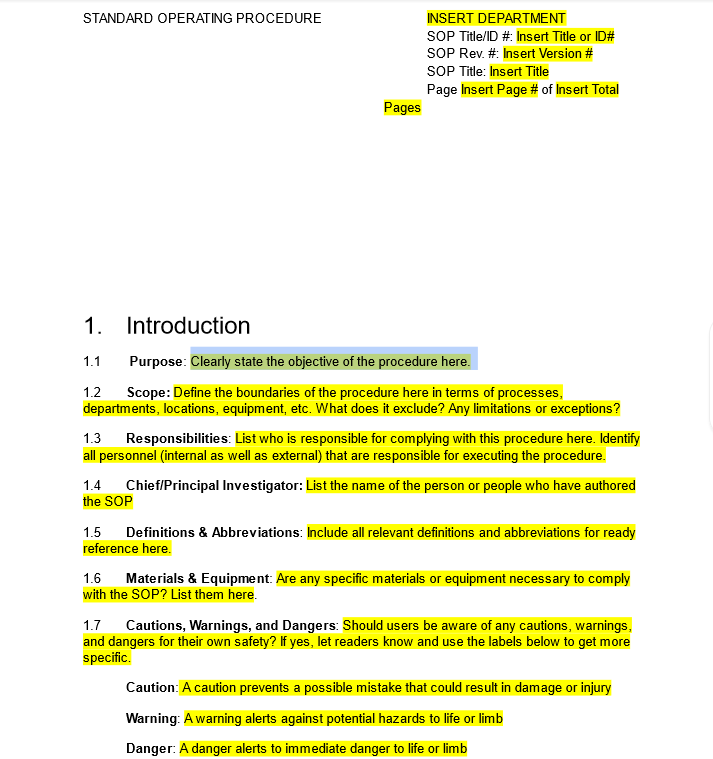
Word | PDF | Google Docs
For additional templates, check out our blog post Free SOP Templates You Can Use Today which contains free standard operating procedure templates for various industries and use cases.
How a Knowledge Base Can Help With Your SOPs
"Before Helpuice, we had documented standard operating procedures but it was problematic. Formatting was inconsistent and they often did not meet best practices. Moreover, because the SOPs were not being managed, outdated materials were in circulation. Additionally, finding these procedures was difficult as they were posted in multiple locations.
With Helpjuice's knowledge base software, we're able to more easily standardize all of our processes, allowing us to be more effective under the quality management initiatives we started about 18 months ago." - Richard Thompson, Sr Project Manager, Collins Community Credit Union
Using a knowledge base offers many benefits for managing and distributing SOPs:
- Centralized Storage. Store all your SOPs in one central location. This ensures everyone can access the most up-to-date versions.
- Searchability. Easily search for and find the SOPs you need. This is especially helpful for new employees or those unfamiliar with the procedures.
- Version Control. Keep track of changes and updates to SOPs. This ensures everyone is using the most current version.
- Collaboration. Share information and ideas about SOPs among employees. This helps keep SOPs effective and up to date.
- Tracking. Monitor which SOPs have been accessed and by whom. This is useful for training and compliance purposes.
Overall, a knowledge base is a powerful tool for managing SOPs. It ensures employees have the information they need to complete tasks consistently and efficiently.
The Bottom Line: Why SOPs Are Essential for Business Success
Creating standard operating procedures is perhaps the best way to ensure your team puts their talents to maximum usage.
In contrast, even the most talented of professionals may not be able to be productive and effective in their position if not given proper and explicit guidance.
Moreover, even if your new SOP aligns with absolute best practices, it won’t do any good if your team isn’t able to access it. This is why a centralized internal knowledge base is vital to the implementation of a new SOP.
With clear-cut, comprehensive standard operating procedures on-hand at all times, your team members will always know exactly what to do in any situation they face. In turn, your organization’s productivity will all but certainly skyrocket.
That's where Wizardshot and Helpjuice are useful. We know how difficult it can be to create SOPs, which is why we created Wizardshot. Wizardshot is a free Chrome extension that allows you to capture your workflow directly from your browser, making it easy to document step-by-step guides with screenshots. This visual approach can be particularly helpful in creating clear and concise SOPs that are easy for your team to follow.
Get Wizardshot for free and experience how easy it is to document your workflows and start creating effective SOPs.
Wizardshot integrates seamlessly with Helpjuice, allowing you to organize, share, and manage your SOPs efficiently. By combining Wizardshot’s workflow capture capabilities with Helpjuice’s powerful knowledge base features, you can ensure that your SOPs are not only well-documented but also easily accessible to your entire team.
Sign up for a free 14-day trial (no credit card required) and see first-hand how Helpjuice's knowledge base software can help you with organizing all your SOP documentation as well as any other internal documents.
